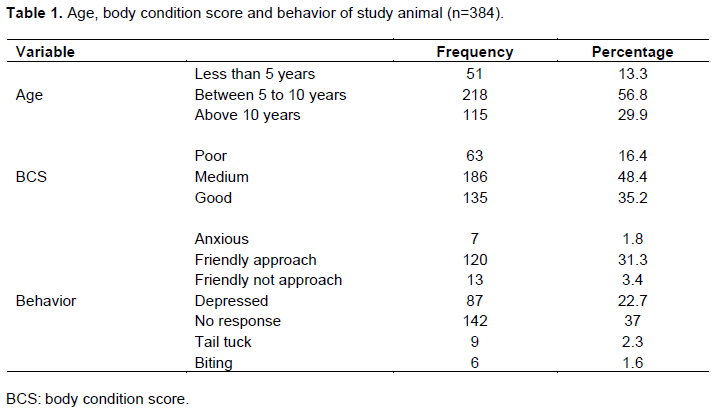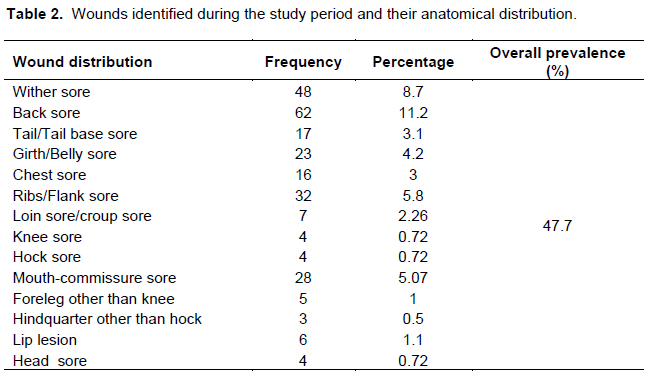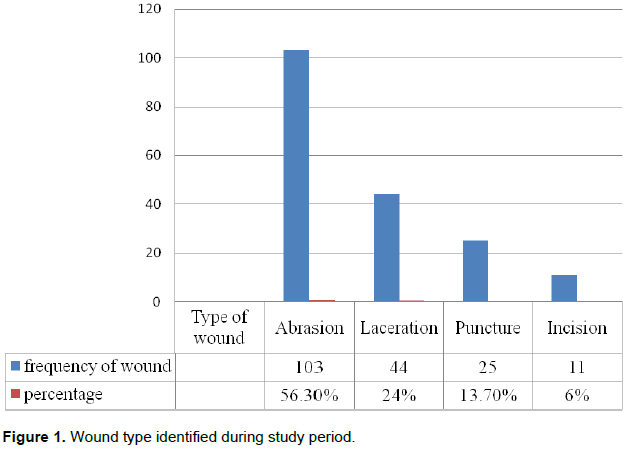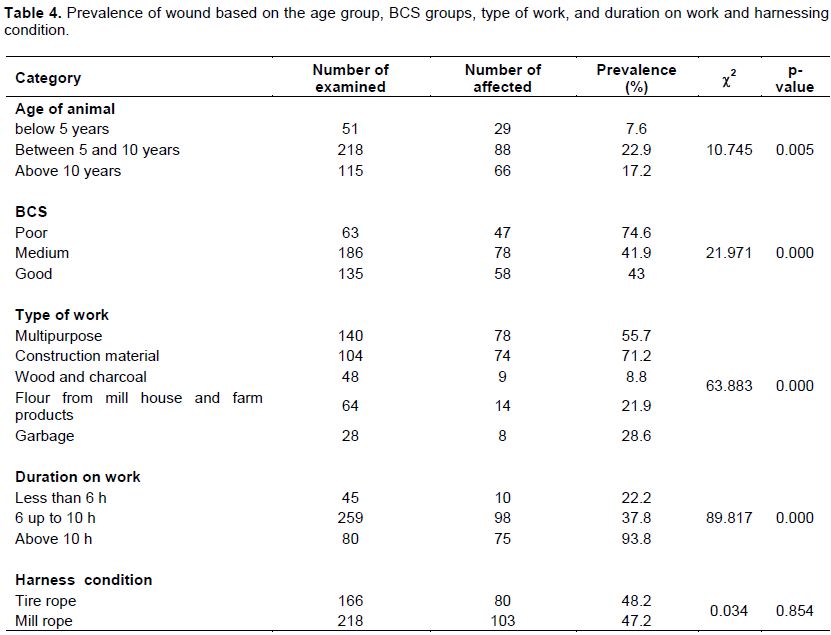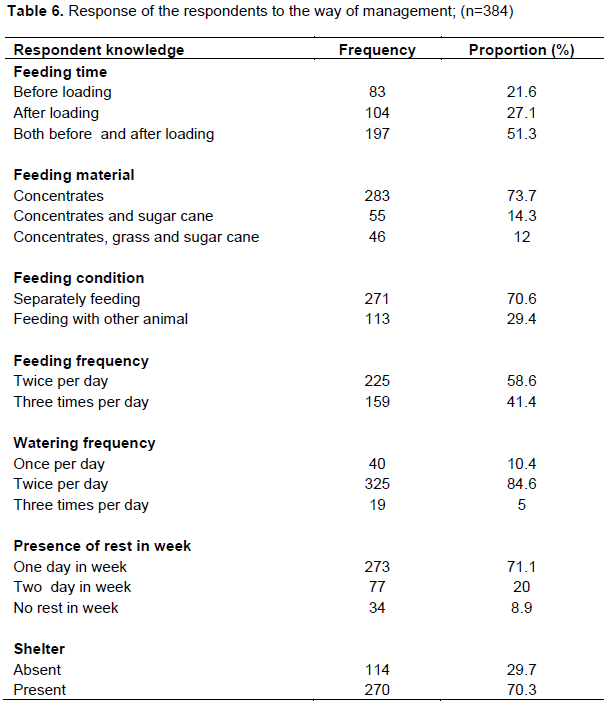ABSTRACT
A cross-sectional study was conducted from November 2016 to April 2017 with the objective of assessing the welfare situation and identifying major health problem of donkeys in association with risk factors identification using physical examination and questionnaire survey in and around Hawassa town, Southern Ethiopia. Three hundred and eighty four donkeys were physically examined for health related and management problems and three hundred and eighty four donkey owners and cart drivers were interviewed for awareness and welfare assessment in the study area. Out of the total 384 donkeys, the prevalence of wound, lameness, skin problem, other illness signs, eye problem, dental problem and change on visible mucous membrane were found in 47.7, 38.8 36.2, 14.3, 9.4, 7.6 and 6.3%, respectively. Statistically significant (p<0.05) association was observed between the occurrence of wound and age, type of work, duration of work and body condition of the study animals. The prevalence of wound in old age groups, poor body conditioned animals, donkeys that transport construction material and those working for more than 10 h were 76.6, 74.6, 71.2 and 93.8%, respectively. Furthermore, the welfare problems association with donkey users’ ownership status, age, and educational status were assessed and 51.3% of cart drivers’ owners, 47.1% young drivers and 62.2% had educational status under grade four and have little experience on handling working donkeys. Out of 384 respondents, 63.2% were not aware of common animal welfare freedoms. The health and welfare problems of cart pulling donkeys in the study area were created and complicated with multiple influential factors. The whole community should participate on awareness creation, introduction of improved design of harnesses and carts, also training on animal welfare to owners should be given to reduce health and welfare problems on donkeys.
Key words: Donkeys, health problems, risk factors, welfare, wound.
The donkey (Equus asinus) is believed to be the first member of the Equidae family that was domesticated (Rossel et al., 2008). The world donkey population is estimated to about 44 million; half is found in Asia, just over one quarter in Africa and the rest mainly in Latin America (Fielding and Starkey, 2004). Ethiopia has the largest population of donkeys in Africa and the second largest donkey population in the world next to China (Kumar et al., 2014).
Equines are important animals to the resource poor communities in rural and urban areas of Ethiopia, providing traction power and transport services at low cost. The use of equines in door-to-door transport service also provides urban dwellers with the opportunity of income generation. The majority of the income generation product of equines mainly comes from donkeys (Biffa and Woldemeskel, 2006; Tesfaye et al., 2016; Abdela et al., 2017; Genetu et al., 2017). Donkeys are one of the most important domestic animals most intimately associated with humans. They contribute a lot through their involvement in different social and economic sectors (Ayele et al., 2006). The donkey is harder than the horse, survives with much less attention, drives sustenance from poor quality food and can tolerate considerable heat and dehydration. This makes it a suitable animal for harsh environments and difficult working conditions. Its main role is that of a beast of burden, typically transporting materials such as grains, fuel wood, water, crop and building materials (Kiros et al., 2016).
Since these animals are working animal, they are always expected to undergo suffering in their day to day life due to stress, strain due to overwork, fatigue due to working with poor health, feed, nutrition and drinking water. Pains are due to unscientific ill-fitting equipments, harness devices, poorly designed agricultural equipments and carts. Non availability of proper veterinary care, working under hot and dusty environment, lack of proper shelter, care and management, crude castration, restraining and tethering devices, walking long distances and overloading, poor handling during loading and unloading and inhumane slaughter is common. Most of the animal owners are not even aware of animal welfare practices and as a result, animals have to undergo significant suffering due to improper handling, transport and husbandry practices (Biswas et al., 2013).
The animal welfare is being compromised due to several constraints such as poverty and lack of knowledge. Research conducted in Ethiopia demonstrated that improvements in the welfare of donkeys had significantly improved their work output which in turn improved livelihood situations of the poorest communities in the rural and peri-urban areas (Smith, 2003). The welfare of working donkeys in developing countries is therefore crucially important, not only for the health and survival of those animals, but also for the livelihoods of those people dependent on them (Wilson, 2002; Pearson and Krecek, 2006).
The causes of poor welfare outcomes frequently identified for working animals include poor nutrition, poor harness design and use, overwork and inappropriate management practices, such as beating and working animals at too young an age. Additional related problems include wounds, lameness, colic in equids and preventable infectious disease. Initiating factors are usually multi-layered. They include traditional or cultural beliefs and economic constraints. Cultural factors can include traditional beliefs in harmful practices such as nostril-slitting and firing. Economic factors commonly constrain marginalized communities from accessing resources such as feed and water, good harnessing and carts, quality shoes, shelter, and health care for their working animals, which all have a direct impact on animal welfare (Rahman and Reed, 2014).
As any other animals, donkeys are vulnerable to a variety of disease of biological origin, nutritional diseases and other miscellaneous cause that leads them to ill health, suffering, considerable loss of work output and reduced longitivity (Gebreab and Fanta, 2007). In countries like Ethiopia they are subjected to a variety of health disorder including multi-parasitism, back sore and other wounds due to different causes, hoof problems, colic, various infectious diseases such as strangles, tetanus and others. Feed shortage and disease are the major constraints to productivity and work performance of equines. The major and common clinical manifestations of disease which affect organs of support are lameness, failure of support, insufficiency of movement and deformity (Amene et al., 2015).
They are brutally treated, made to work overtime without adequate feed or healthcare. They suffer from lack of shelter from sun, rain or biting insects at markets or working sites. These have a potential to negatively affect their welfare and quality of life. This was justified by low number of donkeys presented annually to the clinic compared to other domestic animals; 270 donkeys vs. 20,000 head of other domestic animals such as cattle, between 1987 and 1988 (Yilma et al., 1991).
According to recent central statistical agency (CSA, 2013), there are about 2.03 million horses, 7.43 million donkeys, 0.4 million mules, and about 1.16 million camels in the sedentary areas of the country. In Ethiopia the use of donkeys as pack animal or for pulling cart has enabled small scale farmers to participate in the market economy. Donkeys are used for fetching water, for household shifting, for carrying the sick to hospital, for carrying sick calves, for transportation, and for pulling materials needed for construction. Probably one of the most important limitations is the general lack of information on the proper management and welfare problems of donkeys, which leads them to receive minimum care. Donkey has spent hundreds of years being used by man but, despite that only little attempt has been made to study any aspect of this animal until recently and particularly in countries where they are most important (Amene et al., 2015).
Even though donkeys are used as the source of income generation and provides invaluable and cheap energy for the whole communities in the study area, their health and welfare situation are compromised through poor husbandry practices, lack of animal welfare knowledge, problem of the daily income of drivers, absence of legislation policy for working animal and poor design harness material. In Hawassa and its surrounding, large population of cart pulling donkeys are found, but their health and welfare situation show that they suffer from multi-factor life threatening problems. Therefore this study was planned with the following objectives: to assess welfare situation of cart pulling donkeys in Hawassa town and also to identify major health problems and associated risk factors of the Donkeys in the study area.
Study area
The study was carried out in and around Hawassa Town, Southern Nations, Nationalities and Peoples of Southern Ethiopia. Hawassa is situated at 275 km South of Addis Ababa (the capital of Ethiopia) at latitude between 6°83ꞌ to 7°17ꞌ N and longitude 38°24ꞌ to 38°72ꞌ E on the escarpment of the Great Rift Valley along the Addis Ababa Moyale highway. The altitude ranges from 1650 to 1700 m above sea level. The annual average rainfall and temperature are 955 mm and 20.3°C, respectively. Hawassa is the capital of South nation, nationalities and people region (SNNPR) and has eight sub cities, namely Addis Ketema, Mehal, Menariya, Misrak, Hayk Dar, Behal Adarash, Tabor and Hawela Tula sub cities. The population of donkey (Equus asinus), mule (Equus hemonious) and horse (Equus cabalis) of Hawassa city are 13961, 369, and 5161, respectively (CSA, 2008). A total of five areas of Hawassa were included in the study (Aroge Gebeya, Adis Gebeya, Atena Tera, Alamura Sefer and Hawela Tula Gebeya).
Study animals and sampling procedure
Working donkeys (384) which were used for cart pulling to transport different material were sampled. Working donkeys of all age groups from different localities in and around Hawassa city were randomly selected for the study. The breed of the donkeys were local breed called Abyssinia type with the characteristic feature of short, compact, lower feed requirement and easily manageable. The assessment of welfare and health was done with the corresponding risk factors such as age, behavior, body condition, lameness, harnessing condition, wound distribution and types of wound. Animals were physically examined for their health and problems associated to welfare and owners or cart drivers were interviewed with structured/semi-structured questionnaires.
Sample size and sampling method
A total of 384 donkeys were randomly selected for physical examination and questionnaire survey. The sample size has been determined according to the formula given by Thrusfield (2007) based on expected prevalence of 50%. Based on simple random sampling methods and 95% confidence interval with required 5% precision, the sample size was determined as:
N = Z2 × Pexp [1-Pexp] / d2
Where, N= required sample size, Z= the Z-value at 95% confidence level, Pexp=expected prevalence=50%, and d= required precision.
Study design and methodology
A cross sectional study was carried out on cart pulling donkeys found in five selected areas of in and around Hawassa city. The sites were selected purposively based on their accessibility, easy of logistic and number of donkey populations in the area. The sites were Aroge gebeya, Adis gebeya, Atena tera, Alamura sefer and Hawela Tula gebeya. Donkeys were randomly selected, all are indigenous breeds irrespective of age, sex and body condition score to investigate the health and welfare situation and associated risk factors.
Data collection
Direct assessment
A structured direct assessment format was developed and data was collected by direct physical examination of the animals. Prior to the assessment, consent was obtained from animal’s owners or users after explaining the objective of the study. If the animal owner is not willing, then opportunity was given to the next willing animal owner. The same procedure was continued steadily until the sample size was attained throughout the study period. All sampled animals were physically restrained by animal owner and causal worker. Mouth was thoroughly examined for the presence of any feed pack on teeth. If there is feed pack, the tooth is removed so as not to interfere with age estimation and also cause abnormal teeth identification.
Information regarding general health parameters such as: type of wound, anatomical distribution of wound/physical injuries, lameness, skin problems, problems of visible mucus membrane, and eye conditions and other signs of illness were properly recorded on data collection format. Assessment was carried out at field level, market and around homestead on the day time. Animals were allowed to stand for maximum 10 min after being held by head collar and lead rope assessment began, without causing major disturbance to donkey routine work.
Age determination
Age of the animal was estimated based on the observation of the animal’s front teeth (Incisors) (Crane, 1997). Accordingly, the study animals were categorized into three age groups as less than 5 years, 5 to 10 years, and above 10 years. Dental abnormalities were also observed and recorded. But for the ease of study simplification and absence of donkeys that are too old, this study took three age categories as <5, 5-10 and >10 that are considered as young, adult and old, respectively.
Wound assessment
Body lesions were then recorded with regard to type of wound and anatomical location as wither sore, back sore, tail and tail base sore, girth sore, neck sore, chest sore, mouth-commissure sore, head sore, and other sore in study animal.
Body condition of animal
Body condition score was done according to the criteria described by Pritchard et al. (2005) and animals were examined from all sides. The donkey body condition was scored as 0 to 5 (0 = very thin, 1 = thin, 2 = fair, 3 = good, 4 = fat and 5 = very fat). However, for the purpose of data analysis, body conditions 0 to 5 were categorized into three distinct groups: categories 0, 1 and 2 were grouped as “poor", category 3 was defined as "medium" and body condition scores 4 and 5 were categorized as "Good".
Demeanor of the animal
The behaviors of all animal sampled were assessed as anxious, friendly approach, not friendly approach, depressed, no response, tail tuck and biting which involve an observation of general alertness versus unresponsiveness to the environment to correlate these behaviors with physical problem and diseases (Morka et al., 2014).
Indirect welfare assessment
Semi-structured questionnaire was developed to collect data on the major constraints health and welfare considering use of donkeys, veterinary service, disease management system, management practice (feeding, watering, health care, shelter and resting time), working nature (duration on work, weight carried, length of journey covered, nature of working environment), educational status, and age of donkey cart drivers and other people working on animal. Accordingly, 384 people were interviewed to generate information which was missed during direct assessments of the animal.
Data management and analysis
The data collected from the 384 donkeys and interviews made with 384 drivers were entered into Microsoft excel spread sheet and analyzed using SPSS version 20 statistical software. Descriptive statistics were used to quantify the problems and Chi-square (c2) was used to determine the association of the problem with the risk factors. In all calculations, the confidence interval was set at 95% and statistical significant differences were considered as p<0.05.
Direct assessment results
The direct assessment data was collected by assessing age, work type, body condition, different wound types, distribution of wound, behavior, causes of lameness, origin of lameness, degree of lameness, dental problem, skin problem, mucous membrane problem, and other illness signs observed from the examined donkeys. For the 384 studied animals, results for the distribution of age, body condition and behavior are illustrated in Table 1.
During the study period, the donkeys were thoroughly examined for type of wound and distribution of wound. Out of 384 donkeys sampled, 183 of them were found to be wounded; the overall prevalence of wound was 47.7% (Table 2).
Out of 183 wound exposed donkeys, 56.3% were found with abrasion, 24% were positive with laceration, 13.7% had puncture, and 6% were affected with incision wound (Figure 1).
From the examined donkeys, many health problems were identified with thorough examination of the sampled animal. Out of 384 examined for other illness signs, 14.3% (55) donkeys were positive for other illness signs. For the dental problem examined, 7.6% (29) donkeys had dental problem. The abnormality on visible mucous membrane was found in 6.3% (24) donkeys.
Eye problems were found in 9.4% (36) donkeys. The skin problem was one of the major finding constraints. Out of 384 examined donkeys, 139 (36.2%) were affected. In the study area, donkeys have crucial importance to the transportation of goods. However, lameness is the main problem affecting transport services of the donkeys in the study area. From the total examined donkeys, 38.8% (149) were found with lameness problem. Table 3 illustrates the other illness signs, dental problem, skin problem, eye problem, change on visible mucous membrane problem, degree of lameness and origin of lameness, and causes of lameness. In Figure 2, the grade, causes of lameness and origin of lameness are shown.
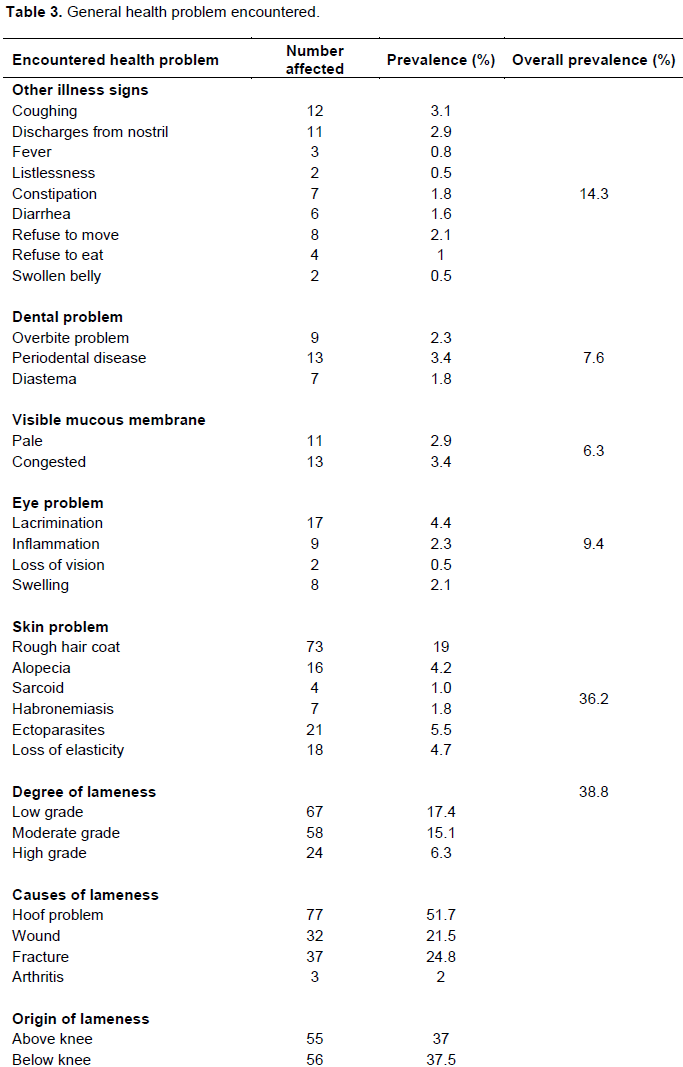


The prevalence of wound associated with different age groups were examined and the statistical association reflects that the donkeys between five and up to 10 years had high prevalence of wound than the age groups of below five and above 10 year (c2 =10.745, P-value=0.005). The prevalence of wound with body condition of the donkeys are highly significant in poor body conditioned donkeys (c2=21.971, P=0.00). Also, there was a statistically significant association observed (c2=63.883, P-value=0.000) for prevalence of wound with the type of work animal used. The prevalence of wound is strongly associated (c2=89.817, P-value=0.000) with duration on work and the donkeys worked above 10 h (Table 4).
Result of questioner survey
Out of a total of 384 interviewed, 51.3% (197) of the respondents are owners of donkeys and 48.7% (187) respondents were not the owners. Age distribution of drivers was 47.1% (181) young, 44.8% (172) adult, and 8.1% (31) old. The drivers educational status were 62.2% (239) below grade four, 32.8% (126) between grade 5 and up to 8, and 5% (19) above grade eight. The survey of experience of working year using this animal were 29.7% below one year, 35.9% one to two years and 34.4% above two years (Figure 3).

Out of the total respondents, 63.2% (243) were not aware of animal welfare, 27.9% were not aware of freedom from thirst and hungry, and 8.9% were not aware of freedom from injury and disease. The animal welfare knowledge source was veterinarian (16.7%), radio programme (9.6%), their friends (3.4%) and world animal day (7%). The drivers’ responses about care for sick animal were 43.2% (166) taken to Government Veterinary Clinic or private clinic, 34.4% (132) given traditional medication and 22.4% (86) left to self-healing. Out of the total respondents, 90.4% (347) owners were forced to use their donkeys that had wound and only 9.6% (37) owners use their donkeys after wound healed. In the study area, 81.6% (313) did not get any training or consultation about animal welfare from Veterinarian and only 18.4% (71) cart drivers were trained on animal welfare and management. The opinion of respondents about responsibility for donkey health and welfare assessed and their response were 42.4% veterinarian, 32% owner, and 25.6% government. Also, respondents reflects different standing on severe diseased or old donkey not used for work purpose: out of 384 respondents, 62.5% (240) owners showed their response to leave out of home and 37.5% (144) owners keep their severed diseased or old aged donkeys not used for work purpose at their home (Table 5).
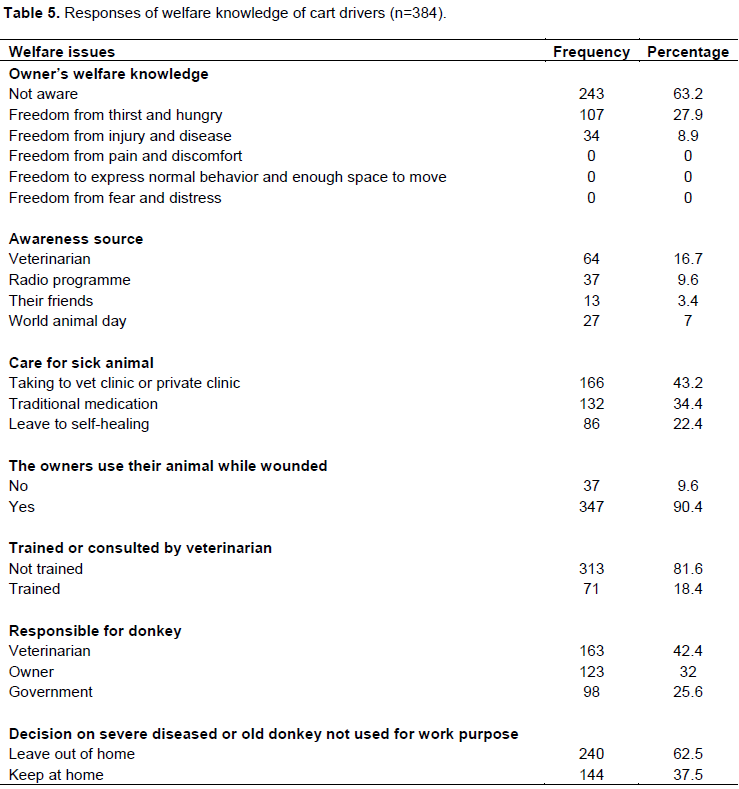
The questionnaire survey result of 384 donkeys drivers and owners interviewed from five selected areas indicated that all animal owners do provide water and feed to donkeys at home and working places, out of 384; only 70.3% (270) provide shelter to donkeys at their home and 29.7% (114) of the owners of cart donkeys in and around Hawassa city reflected that they could not provide shelter at home specially at night and they keep their donkeys in fenced compound without any shade paying off fee; this is due to the fact that the owners do not have their own house and live in rented homes as a result of this, donkeys were exposed to different welfare problems. 41.4% fed their donkeys three times per day and 58.6% fed their donkeys twice in day. The owners fed their donkeys depending on the income they got daily and availability of feeding material (Table 6).
In Hawassa, all donkeys are kept to transport different materials in order to insure their owners’ daily income. This study is in agreement with reports by Usman et al. (2015), Solomon et al. (2013) and Pritchard et al. (2005) describing that equids are mainly kept for transport purposes and only rarely as source of meat or milk. The current study revealed that 100% of the owners were using their animals for transportation or carrying load for more than 6 h a day in average which is in agreement with Biswas et al. (2013) and Panwar et al. (2008).
In this study area, 47.7% donkeys population had overall prevalence of wound, 56.3% were found with abrasion, 24% were positive with laceration, 13.7% had puncture and 6% were affected with incision wound. Similarly, the finding of Fikru et al. (2015) reported that 50.6% of abrasion wound was examined from the same study area. During the study period, the wound was classified depending on the anatomical distribution and result indicated that the high frequency of back, wither, ribs/flank, mouth-commissure, tail/tail base and chest wound were examined. The current study agreed with those of Helen (2001) who reported similar situation in the Northern Ethiopia and this higher prevalence of wound at the back region could be due to improper harnessing that cause injuries in working donkeys. Similarly, the present result also agrees with the previous report of Mandefro (2008), in which, those ill-fitting and improperly made tail straps that usually has sharp edge, causes lesions on the underneath of the base of tail of working donkeys.
In current study, wound had higher prevalence than the reports of Morka et al. (2014) in and around Nekemte Town, East Wollega Zone (38.4%) and lower prevalence of donkey wound than the result of Fikru et al. (2015) and Biffa and Woldemeskel (2006) who revealed 63.4 and 79.4%, respectively. These differences might be due to variation in care for animal health, management practices, the weight of load and the work type of the donkeys in the region. All the donkeys examined for the present study were used for cart pulling purpose in the study area.
The current study revealed that higher prevalence of wound was examined in above 10 year old donkeys (48.1%) than other age groups. This finding is in line with those of Tesfaye et al. (2016) who reported 69.2% wound in older age groups than other age groups. This study agreed with reports of Biffa and Weldemeskel (2006) in Hawassa who reported that older equines had greater wound risk than other age group. This might be due to more exposure to work and carrying heavy load over a long distance, less owners’ attention to wound management and also the immune defense mechanism also reduce with age advancement.
There was significant association between prevalence of wound and body condition (P=0.000) with 74.6% of poor body conditioned donkeys affected with wound. This result was found to be in agreement with the reports of Abdela et al. (2017), Tesfaye et al. (2016), Tsega et al. (2016) and Henneke et al. (1983) who reported strong association between prevalence of wound body condition. These might be due to dehydration which decreases the elasticity of the skin in poor body condition animals and the prominence of bones leading to easy skin injury.
In this study, the prevalence of wound and type of work donkeys regularly involved has significant association (p=0.000). The donkeys commonly used for transporting construction materials were found to be wounded (71.2%) than donkeys transporting other materials. This is due to the transportation of highly loaded metals, sand, cement, stones and woods from far distance for long time without rest. This study is not in agreement with those of Tesfaye et al. (2016) in Mirab Abaya, Gamo Gofa and Kumar et al. (2014) in Mekele who reported that the highest prevalence was recorded in charcoal transporting donkeys (52.1%). This may be due to burning characters of charcoal and wider surface area of sack that lay on the back of the donkeys in which the whole surface not covered by proper harness leads to at least injury in one area of the anatomical location.
In the present study, the prevalence of skin and skin associated problems were found with overall prevalence (36.2%). These findings are higher than Mulisa et al. (2015) in Wolaita zuria (12.6%), Kumar et al. (2014) in Mekelle city (23.7%) and Tesfaye et al. (2016).
In the current study, eye problem and dental problem were identified as the health problem of the studied animals in the study area with overall prevalence, eye problem (9.4%) and dental problem (7.7%). This result disagrees with those of Tesfaye et al. (2016) in Mirab Abaya, Gamo Gofa zone with prevalence with unilateral eye problem (5.4%), bilateral eye problem (11.4%) and dental problems (11.5%). But these outcomes are lower than that in the report of Kumar et al. (2014) in Mekelle city; 19.3% eye problem and 16.2% dental problem and higher than the report of Abutarbush et al. (2014) with 4% problem in Jordan. These differences might arise due to difference in topographical nature and misuse, low level of donkey health care keeping characteristics, feeding characteristics and age of working donkey.
The present study revealed that 77.6% of respondent provide care for their donkeys (43.2% taken to government veterinary clinic or private clinic and 34.4% traditional medication) and 22.4% left to self-healing. Also, most of the owners are forced to use their donkeys having wound (90.4%). The result is closely related with those of Tesfaye et al. (2016) in Mirab Abaya that showed 84.2% of the respondents provide care for their sick animal out of which 48.3% took donkey to nearby veterinary clinic.
In this study, the owners fed their donkeys depending on the income they got daily and availability of feed. The responses for supply water to animal were 10.4% once in day, 84.6% twice in day and 5% three times in day. The result of the study shows that 51.3% fed their donkeys both before and after loading at home and working places. However, in the report of Tesfaye et al. (2016), 48.3% provided feed before loading only.
The current study indicated that 70.3% provide shelter to donkeys at their home and 29.7% of the owners keep their donkeys in fenced compound without any shade paying off fee. This result agree with those of Morka et al. (2014) with 76.6% providing shelter to equine at home and 23.6% of the owners of cart horses in Nekemte town reflected that they could not provide shelter at home especially at night and they release them to the street or forest after work. This is due to the fact that to cover a wide range of role of equine, the owners do not have their own house and live in rented homes as a result of this, animals were exposed to predators’, environmental factors, car accident and easily stolen by thieves.
The present study revealed that the cart pulling donkeys in and around Hawassa were faced the multi-factorial health and welfare problems. Poor design wood worked carts, no standard in harnessing equipment, absence of approved policy in working animals, poor animal welfare knowledge, dependence of daily income source on cart work, overloading, overworking and work types were major factors causing health and welfare problems. In the current study, abrasion, laceration, puncture and incision were the identified wound types. Furthermore, the distribution of wound on different body parts were assessed and back sore, wither sore, mouth-commissure sore, tail/tail base sore, ribs/flank sore, chest sore and girth/belly sore were the major wounds examined on working donkeys. Lameness problem, skin problem, other illness signs, and dental problems frequently occurred in donkey’s health situation in this study area. Lack of awareness of animal welfare knowledge and less attention to husbandry practices to feeding management, housing condition, watering the donkeys, and heath care of animals were indicators of the minimum understanding of the health and welfare of this study population. These situations strongly call for awareness creation on animal welfare by government and charity organizations interested in animal welfare. The country should also have policy on working animal handling and management. The standardized harnessing equipment should be available in market. Moreover, the donkey sanctuary model carts should be used for all cart pulling donkeys.
The authors have not declared any conflict of interests.
REFERENCES
|
Abdela N, Teshome E, Hassan A, Deressa FB (2017). Prevalence and associated risk factors of equine wound in and around Asella town, South Eastern Ethiopia. J. Vet. Med. Anim. Health 9(4):63-71.
Crossref
|
|
|
|
Abutarbush SM, Alqawasmeh DM, Shaheen ZH, Anani SF, Ledger MP (2014). Equine Diseases and Welfare in Jordan: A Retrospective Study (1261 cases). Jordan J. Agric. Sci. 10(3).
|
|
|
|
|
Amene F, Hiwot T, Teshome W (2015). Epidemiology of Lameness among Cart Pulling Donkeys in Hawassa City Administration, Southern Ethiopia. Acad. J. Anim. Dis. 4(2):52-59.
|
|
|
|
|
Ayele G, Feseha G, Bojia E, Joe A (2006). Prevalence of gastro-intestinal parasites of donkeys in Dugda Bora District, Ethiopia. Livest. Res. Rural Dev. 18(10):14-21.
|
|
|
|
|
Biffa D, Woldemeskel M (2006). Causes and factors associated with occurrence of external injuries in working equines in Ethiopia. Int. J. Appl. Res. Vet. Med. 4:1-7.
|
|
|
|
|
Biswas P, Dutt T, Patel M, Kamal R, Bharti PK, Sahu S (2013). Assessment of pack animal welfare in and around Bareilly city of India. Vet. World 6(6):332-336.
Crossref
|
|
|
|
|
Crane M (1997). Medical. In: Svendsen, E. (ed) The professional hand book of the donkey. 3 ed. w140 by London: Whittet Books LTD. P 29.
|
|
|
|
|
Central Statistical Agency (CSA) (2013). Federal Democratic Republic of Ethiopia Central Statistical Agency. Agricultural Sample Survey (2012/13 [2005 E.C). Volume II, Report on Livestock and Livestock Characteristics. Statistical Bulletin 570. Addis Ababa, Ethiopia. Available at:
View
|
|
|
|
|
Central Statistical Agency (CSA) (2008). Federal Democratic Republic of Ethiopia. Central Statistical Agency, Agricultural sample survey report on livestock and livestock characteristics. Volume II, 2007/08. Addis Ababa, Ethiopia. Available at:
View
|
|
|
|
|
Fielding D, Starkey P (2004). Donkeys, people and development: Resource books in the animal traction network for Eastern and Southern Africa (ATNESA), ACP-EU Technical Centre for Agricultural and Rural Cooperation (CTA), Wageningen, Netherland.
|
|
|
|
|
Fikru A, Tadese A, Gebreegziabher Z (2015). Prevalence of Equine Wound and Associated Risk Factors in and around Kombolcha Town, North Ethiopia. J. Vet. Sci. Technol. 6:234.
|
|
|
|
|
Gebreab F, Fanta A (2007). Saddle harness development and trial. In Fifth International Colloquium on Working Equines. The future for working equines. Addis Ababa, Ethiopia, 30 October-2 November, 2006. The Donkey Sanctuary. pp. 41-47.
|
|
|
|
|
Genetu H, Yohannes G, Abdela N, Ibrahim N (2017). Prevalence of Wounds and Associated Risk Factors in Working Equines in Jimma Town of Oromia Region, South-Western Ethiopia. Acad. J. Anim. Dis. 6(2):23-29.
|
|
|
|
|
Helen B (2001). The Gharry horses of Gonder. Draught Animal News. Centre for Tropical Veterinary Medicine: University of Edinburgh, Scotland. 35:23-24.
|
|
|
|
|
Henneke D, Potter G, Kreider J, Yeates B (1983). Relationship between body condition score, physical measurement and body fat percentage in mares. Equine vet. J. 15(4):371-372.
Crossref
|
|
|
|
|
Kiros A, Gezahegn M, Aylate A (2016). A cross sectional study on risk factors associated with lameness of working donkeys in and around Hawassa, Ethiopia. J. Anim. Health Prod. 4(3):87-94.
Crossref
|
|
|
|
|
Kumar N, Fisseha KK, Shishay N, Hagos Y (2014). Welfare Assessment of Working Donkeys in Mekelle City, Ethiopia. Glob. Vet.12(3):314-319.
|
|
|
|
|
Mandefro A (2008). A study on harnessing problems of working donkeys in Sidama zone. DVM Thesis, Addis Ababa University, Faculty of Veterinary Medicine, Debre-Zeit.
|
|
|
|
|
Morka A, Adisalem H, Bojia E, Eyob H, Bedasso M (2014).Health and Welfare Assessment of Working Equine in and Around Nekemte Town, East Wollega Zone, Ethiopia. Amer-Euras. J. Sci. Res. 9(6):163-174.
|
|
|
|
|
Mulisa M, Tamirat H, Ayalew N, Teka F (2015). Assessment on Working Donkey Welfare Issue in Wolaita Soddo Zuria District, Southern Ethiopia. Glob.Vet 14(6):867-875.
|
|
|
|
|
Panwar S, Tripathi H, Bhanja SK, Kumar S (2008) Animal welfare practices followed by pack animal owners- an investigative study. Centaur 25(1):7-19.
|
|
|
|
|
Pearson RA, Krecek RC (2006). Delivery of health and husbandry improvements to working animals in Africa. Trop. Anim. Health Prod. 38(2):93-101.
Crossref
|
|
|
|
|
Pritchard JC, Lindberg AC, Main DC, Whay HR (2005). Assessment of the welfare of working horses, mules and donkeys, using health and behavior parameters. Prev. Vet. Med. 69:265-283.
Crossref
|
|
|
|
|
Rahman AS, Reed k (2014). The management and welfare of working animals: identifying problems, seeking solutions and anticipating the future. Revue Scientifique et Technique International Office of Epizootics 33(1):197-202.
Crossref
|
|
|
|
|
Rossel S, Marshall F, Peters J, Pilgram T, Adams MD, O'Connor D (2008). Domestication of the donkey: Timing, processes, and indicators. Proceed. Natl. Acad. Sci. 105(10):3715-3720.
Crossref
|
|
|
|
|
Tesfaye S, Deressa B, Teshome E (2016). Study on the Health and Welfare of Working Donkeys in Mirab Abaya District, Southern Ethiopia. Acad. J. Anim. Dis. 5(2):40-52.
|
|
|
|
|
Smith D (2003). Final technical report R7350: Use and management of donkey by poor society's peri-urban areas of Ethiopia.
|
|
|
|
|
Solomon M, Matusala M, Rahmeto A (2013). Management practices and welfare problems encountered on working equids in Hawassa town Southern Ethiopia. J. Vet. Med. Anim. Health 5(9):243-250.
|
|
|
|
|
Thrusfield M (2007). Veterinary Epidemiology. Third Edition, Blackwell Science Ltd, Oxford. pp. 244-259.
|
|
|
|
|
Tsega AM, Worku Y, Tesfaye T, Nazir S (2016). Prevalence of wound and associated risk factors of donkeys in Merawi District, North Western Ethiopia. J. Anim. Res. 6(5):765-771.
Crossref
|
|
|
|
|
Usman S, HaimanotDisassa TK, Kebede TZ (2015). Health and welfare related assessment of working equine in and around Batu Town, East Shoa, Central Ethiopia. Nat. Sci. 13(10):1-8.
|
|
|
|
|
Wilson RT (2002). Specific welfare problems associated with working horses. In: Waran, N (ed.): The welfare of horses. Dordrecht: Kluwer Academic Publishers. pp. 203-218.
Crossref
|
|
|
|
|
Yilma J, Feseha G, Svendsen E, Mohammed A (1991). Health problems of working donkeys in Debrezeit and Menagesha Regions of Ethiopia. In: D. Fielding and R.A. Pearson (Editors). Donkeys, Mules and Horses in Tropical Agricultural Development, CTVM, Edinburgh. pp. 151-155.
|
|
